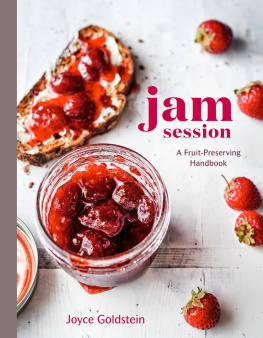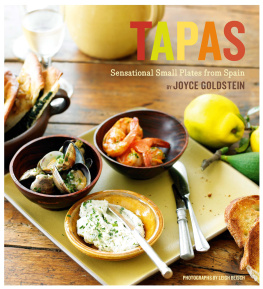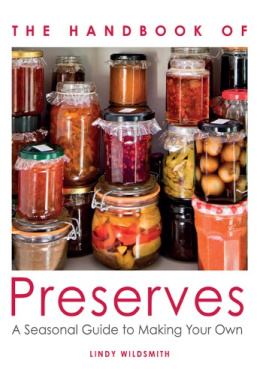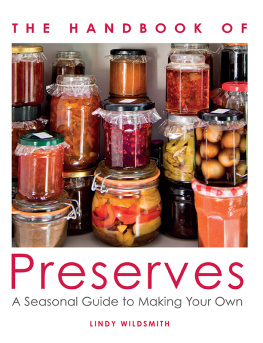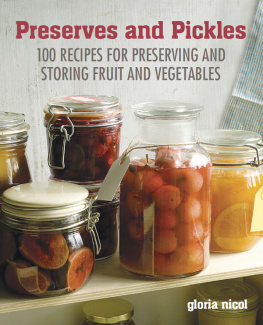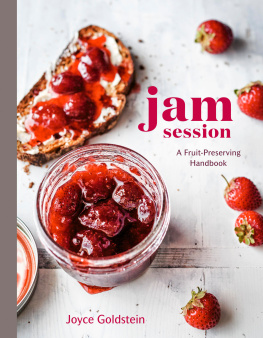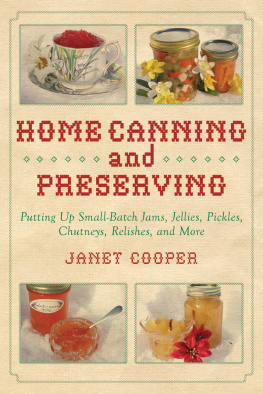Contents
JOYCE GOLDSTEIN is a former Chez Panisse chef; the retired chef/owner of James Beard Awardwinning restaurant Square One; and the author of twenty-eight books. Her preserves are sold at gourmet locations, such as Bi-Rite Market in San Francisco and Bread Furst in Washington, DC, and enjoyed by her very lucky grandchildren. She lives in San Francisco.
ACKNOWLEDGMENTS
Thank you to
My daughter-in-law Barbara Pino, for being my preserving partner.
My grandchildren, Elena, Adam, and Antonio, for loving Grandmas preserves.
Bill LeBlond, for connecting me with Lorena Jones and enjoying many preserves.
Dave McElroy, for serving my preserves at his many dinners and fundraisers.
Mark Furstenberg, for carrying my membrillo at Bread Furst Bakery in Washington, DC.
Jo Lynne Lockley, for her prolific Sorrento lemon tree.
Sam Mogannam and Simon Richard and Jason Rose at Bi-Rite market, for carrying my preserves and membrillo.
My wonderful quince network: Adrian Card, Suki Weir, Mattole Meadows, David Cooper at Oak Hill Farm, and Tim Bates at the Apple Farm in Philo.
Cliff Jones at Greenleaf Produce, for getting currants and black raspberries.
CUESA, for running our Ferry Plaza Farmers Market and for my greatly appreciated chef parking pass.
Publisher and editor Lorena Jones, for wanting a preserving book just as I was wanting to do one.
Photographer Ed Anderson, whose work is earthy and beautiful and who I always love running into at the market.
Food stylist Christine Wolheim, for her artistry on set.
Creative Director Emma Campion, for visual guidance.
Senior Art Director and designer Kara Plikaitis, for elegant layout.
Senior Production Designer Mari Gill, for all the finishing touches.
Production manager Jane Chinn, for beautiful printing.
Publicist Erin Welke and marketer Allison Renzulli, for their creativity in getting the word out.
And thanks also to the following farms and farmers at the Ferry Building:
Al Courchesne at Frog Hollow Farm
Aomboon (Boonie) Deasy at K & J
Bill Crepps at Everything Under the Sun
Bella Viva Orchards
Brokaw Ranch Company
Joe Schirmer at Dirty Girl Farm
Kenny Baker at Lonely Mountain Farm
Knoll Farms
Lagier Ranches, Inc.
The Loewen family at Blossom Bluff Orchards
Lucero Organic Farms
The Peach Farm
Poli Yerena at Yerena Farms
Rojas Family Farms
Swanton Berry Farm
Tim Bates at The Apple Farm
Tory Farms
Twin Girls Farm
Strawberries
Strawberries are the most popular berry worldwide, and strawberry jam is probably the most popular jam. I agree with food writer Jane Grigson, who said that strawberries and raspberries are rarely improved by complication. The less done to them the better. No chutneys, mostardas, or offbeat condiments. I worry whenever the strawberry industry has competitions to invent complicated and novel dishes using cooked strawberries, because the contestants creations rarely show the fruit in its best light.
Ripe strawberries should be eaten or preserved within a day or two. Shop for flavor (the farmers will always let you taste one) and aroma. Serve them at room temperature if you are eating them out of hand.
The average supermarket strawberry is designed for showthe larger the better for display and to dip in chocolate. Most often the large berries are hollow in the center, watery, and lack perfume. Many are grown in pesticide-saturated soil, so my advice is to buy only organic berries. The most popular varieties are Chandler, Albion, and Seascape. As the season progresses from April through the summer, the berries get smaller, so if you are interested in putting up whole-berry preserves, keep this in mind. Your patience will be rewarded.
The main variable with strawberry jam is texture. If the berries are large, you will want to hull them and cut them up into slices or smallish pieces. Some recipes suggest chopping them. Others call for mashing the berries with a potato masher. I do not see any reason for such abuse. They are so tender that when you cook them, they soften enough to meld into a cohesive jam. Texture is a very personal matter; you may want them to be universally mashed and smooth. I do not mind seeing a soft slice. Strawberry jams will not set up firm but will be a soft set.
If you have access to small berries, show them off and preserve them whole. They are most elegant in this way. And because they are tender, they do not roll off the toast.
Strawberries are a member of the rose family. You may want to try using rose sugar (see ) in a batch to see if you like it, substituting it for about a third of the sugar. Keep lemon juice on hand so the preserve is not too cloying and the perfume of the berries comes through.
Simpatico flavorings for strawberries are vanilla, lemon, star anise, real balsamic vinegar, black pepper, pomegranate, mint, basil, and rose.
Strawberries can be paired with rhubarb or currants for a spectacular tart-sweet jam. But few markets carry currants, so you may have to special order them.
Strawberry jam is perfect spread on toast, biscuits, and pancakes; stirred into yogurt; and spooned over ice cream. And, of course, slathered on good old PB&J.
BASIC STRAWBERRY JAM
Because strawberries are not high in pectin, some should be ripe and some underripe. Lemon juice will do the rest of the work.
8 cups (4 pint baskets) strawberries, three-quarters ripe and one-quarter not so ripe
4 cups granulated sugar
Juice of 2 lemons
1 vanilla bean (optional)
Yield: 7 half-pint jars
Place 3 or 4 small plates in the freezer.
Rinse, dry, and hull the strawberries. Cut them into -inch slices.
In a large preserving pot, gently combine the strawberries, sugar, and lemon juice and toss to mix. Set aside to macerate overnight.
The next day, add the vanilla bean, place the pot over medium-high heat, and bring to a boil. Cook for 5 minutes, watching closely because the berries can quickly boil over and you do not want to spend the morning cleaning your stove top. Remove the pot from the heat and let sit, uncovered, for 1 to 2 hours.
Place a baking sheet on the counter near your stove. Heat a kettle of water. Set two stockpots on the stove and fill them with enough water to cover the jars by 1 to 2 inches. Bring the water to a boil over medium-high heat. Sterilize the jars (see ) in the water bath.
Bring the strawberry mixture to a boil again over medium-high heat and cook for 3 to 5 minutes, until the berries are tender. At this point, decide how much texture you want in your jam.
If you want to see a few berry slices in your jam, set a colander over a bowl and, using a slotted spoon, transfer the strawberries to the colander and set aside to rest for 1 hour. Add any strawberry juices that have collected in the bowl under the colander to the preserving pot. Taste the liquid and add lemon juice if the strawberry juice is not tart enough. Reduce the strawberry syrup over medium-low heat, stirring frequently, until thickened. Carefully return the berry slices to the jam pot. While stirring, bring to a boil and cook the jam briefly, until it passes the plate test (see ), forming a soft set and not running much when you tilt the plate.
If you want to make a smooth jam without any visible slices, after you cook the mixture for the first 3 to 5 minutes, mash the berries with a potato masher. Continue to cook the jam until the berries break down and become a soft puree and the jam passes the plate test, mounding on the plate for a soft set. Remove the pot from the heat. Remove the vanilla bean.

